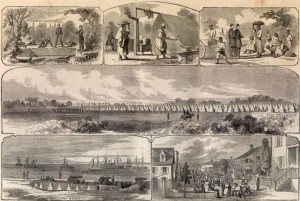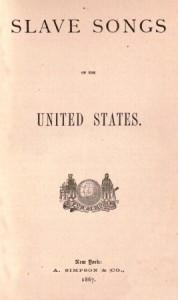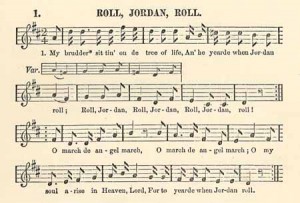Abstract :
The article puts the spots on Lucy McKim, whose role in the documentation of the sounds of slavery is largely underestimated. The publication at her initiative of two slave songs in 1862 is situated against the historical context of the battle at and the experiment of Port Royal. The major significance of this publication becomes manifest in the light of the nature of the approach that was practiced until then in relation to the music and dance performed by the slaves. However, the focus of McKim’s attention on the slave singing within religious surroundings is symptomatic of the context of Christianisation that aimed to replace the “barbarism” of the African culture with the pious religious values.
______________________________________
Port Royal Harbour, situated halfway between Savannah, Georgia and Charleston, South Carolina. The morning of November the 7th, 1861. There was tension in the air because already a few days earlier the war fleet of the Unionists had started to assemble at the entrance of the sound, but that day the morning was beautiful. The sea flowing in the Broad River between Hilton Head Island and the Phillip Island, separated by about 3 miles, was smooth as glass. At about 9 o’clock the silence was abruptly disturbed by the canon fire from the broad decks of an impressive Union armada, advancing in battle array. The fighting ships sailed into the Port Royal inlet and established a long elliptical course between the two forts meant to defend the site, first bombarding Fort Beauregard, reloading on the turn, and then bombarding Fort Walker on the Hilton Head Island on return. With each revolution made by the war boats the ellipse was enlarged, bringing them nearer to the forts. At about 3 o’clock in the afternoon the Confederates were forced to abandon their forts and the islands. The Confederate army had not been a match for the Unionist from the start of the battle and explains why relatively few victims at either side were made.
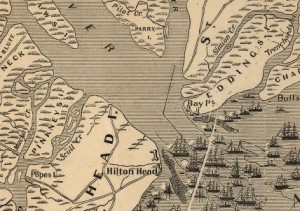 The Battle at Port Royal was the start of a new era in American history. Beaufort was the first Southern city captured by Union forces, remaining in their hands throughout the war. The slaves, working on the cotton and rice plantations, welcomed the victory, and though not immediately freed, they never returned to slavery: they were among the first slaves who were freed after the “Emancipation Proclamation” of 22nd of September 1862 by President Abraham Lincoln. For the Union army, the harbour was a strategic front line that enabled the Northern colonies to control the South-East seaside.
The Battle at Port Royal was the start of a new era in American history. Beaufort was the first Southern city captured by Union forces, remaining in their hands throughout the war. The slaves, working on the cotton and rice plantations, welcomed the victory, and though not immediately freed, they never returned to slavery: they were among the first slaves who were freed after the “Emancipation Proclamation” of 22nd of September 1862 by President Abraham Lincoln. For the Union army, the harbour was a strategic front line that enabled the Northern colonies to control the South-East seaside.
The location of Port Royal has however also entered history as the sad reminder of a lost opportunity to create a more egalitarian society. Left with fields rich of the world famous cotton and with some 10.000 slaves that had remained behind when the planters had run off, the Unionists had to deal with an exceptional situation. A new system had to be built up on the South Carolina’s Sea Islands that was in complete disorder after the collapse of the political and economic tissue. The solution came from a program that was conceived along the lines of political, military, economical and humanitarian considerations.
Already in January 1862 teachers were sent from the North to train the ex-slaves. Three months later a Boston attorney, Edward L. Pierce, was officially charged to begin what has been called the “Port Royal Experiment”. Its aim was to create schools and hospitals for ex-slaves and to allow them to buy and run plantations.
Another dimension of the experiment was to recruit and train the former slaves for soldiers in the military campaigns and have them fight next to white soldiers. For the Northern abolitionists and the anti-slavery organizations, the experiment was a major opportunity to proof that the freedmen and women could become self-sufficient. Theirs was a dream of an integrated social and political Union comprised of people from both races and cultures. If successful, it could bring forth arguments in favour of the superiority of free labour and would be a vehicle to transplant Northern values to remodel the Southern society. A successful experiment would invalidate the widely held supposition that slaves, free or not, were not even capable of being educated.
African Americans did demonstrate that they were able to work the land efficiently and to live independently of white control. During the first year of occupation African American field hands harvested a good deal of the cotton crop and were paid $1 for every 400 pounds harvested. They were the first former slaves freed by Union forces to earn wages for their labour.
Next to their assigned daily tasks for growing cotton, the residents of Port Royal had extra time to cultivate their own crops, fish, and hunt. Small amounts of property were acquired with the sale of the surplus of the crops. Nearly 40,000 acres of abandoned Confederate plantations were offered to be divided among some 16,000 African American families. Local blacks bought about 2,000 acres of land. Also White Northerners purchased land and established holdings which supported several hundreds of black families.
Religious educators had meanwhile merged religion and teaching instruction and had set this way a beginning for the combining of secular and Biblical teaching in America. School buildings rose up. Hundreds of people came forward and women came carrying their children on their hip or back. They travelled for miles along dusty roads to reach the new schools. The Christianisation proofed to be an efficient medium for reducing the illiteracy.
Despite the very broad media attention, the enthusiasm for the Port Royal Experiment began to wane as the victory of the Unionists was on the horizon. The political climate changed, emphasizing voting rights rather than land ownership as the catalyst for black progress. The conservative political elite were also increasingly afraid of what might come out the large scale land confiscation. The momentum of the whole experiment was totally taken away with the death of President Abraham Lincoln in April 1865. The new president, Andrew Johnson started the process to restore all lands back to their previous white owners.
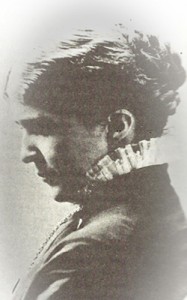 It was in this context that on June 2nd 1862 – whilst the Civil War continued its devastating and bloody course on the mainland – a young, handsome lady named Lucy McKim left New York bound for the Sea Islands to accompany her father, James Miller McKim, as secretary in his information mission on behalf of the Philadelphia Port Royal Relief Committee. Though she would only remain in the Union enclave for about three weeks, “the impressions made on her by the songs of the freedmen were to have lasting effects on the American music” (Epstein, 2003: 31). (1)
It was in this context that on June 2nd 1862 – whilst the Civil War continued its devastating and bloody course on the mainland – a young, handsome lady named Lucy McKim left New York bound for the Sea Islands to accompany her father, James Miller McKim, as secretary in his information mission on behalf of the Philadelphia Port Royal Relief Committee. Though she would only remain in the Union enclave for about three weeks, “the impressions made on her by the songs of the freedmen were to have lasting effects on the American music” (Epstein, 2003: 31). (1)
Her father, James Miller McKim, born in 1810, was an active abolitionist and advocate for freed slaves’ rights. He lectured extensively, worked with the Underground Railroad (an informal network of secret routes and safe houses used by the slaves to escape to free states and to Canada), co-founded the American Anti-Slavery Society, and frequently testified in court cases on behalf of freed slaves snared by the Fugitive Slave Law. Lucy was born in Philadelphia on October 30th 1842 as the first of two children of James McKim and his spouse Sarah Allibone Speakman, the daughter of a Quaker farmer in Pennsylvania whose place was a regular stop on the Underground Railroad. At the age of 15, Lucy began teaching piano at home but would later go back to her former school to study and teach, extending her skills to the violin. Though she was not regarded as a highly talented musician, she was well trained by the standards of her day, having different European composers on her repertoire.
So, when she started her journey to the Sea Islands as a young lady of almost 20 years, she had a decent musical background, combined with an active interest, as her parents, in the anti-slavery cause. It is not known to which extent she was acquainted beforehand with the music performed by the African Americans, but her enthusiasm for it once arrived on the Sea Islands, mixed with her political, humanitarian and musical interests would proof to be a most fortunate cocktail.
Lucy McKim is mostly known as one of the three editors of “Slave Songs of the United States”, a collection of African American music published in 1867. The document was the most influential collection of spirituals to be published, put together by the Northern abolitionists, William Francis Allen, Charles Pickard Ware and Lucy McKim. “Slave Songs of the United States” is widely recognized as a landmark not just in African American music but in modern folk history. Lucy McKim’s contribution to the work is however relatively minor, being credited with only 3 variant versions of a song. 
It is however not the first published collection of African-American music. Epstein (2003) has unearthed two slave songs which were published already five years earlier at the initiative of Lucy McKim. These publications were as far as is presently known the first attempts to preserve slave’s musical expression in a serious matter, staying as closely as possible to the sound in its natural surroundings. The songs (Poor Rosy, Poor Gal & Roll, Jordan Roll) are reproduced in Epstein (2003: 263-269).
What makes the publication of those two songs in 1862 so special? It was the first time ever that somebody with a musical background and knowledge had tried to transcribe the words of a slave song as they were heard, paying due attention to the rhythm and the sense of the text and trying at the same time to stay as close as possible to the original dialect. Lucy McKim also wrote the musical arrangements for the songs consisting of solo voice with “unpretentious piano accompaniments”. Such precise performance directions were a precedent never seen before.
The two songs were included in a letter she wrote on November 1st 1862 to the Journal of Music that published them under the heading: “Songs of the Port Royal Contrabands’. This publication of spirituals was far in advance of anything published so far and – as said – the first to describe the slave music in terms of its style and technique, rather than from a religious, political or racial point of view, or without trying to deform the original dialect. By reproducing the songs in their musical notation, she let the music speak for itself. Her letter to the Journal of Music shows moreover that she was well aware of the historic importance of her transcriptions. Though the publication did not meet with much public reaction, Lucy McKim’s efforts merit to be seen as a milestone in the documentation of the American music.
Indeed, before the publication in the Journal of Music, there is no knowledge of a systematic effort to document slave music. The prior documentation that has been found so far is fragmentary and occasional, and does not in any way allow for an exhaustive, complete view on the sonic landscape in the antebellum period.
The sources (unearthed so far) stem mainly from non-expert narratives written by individuals without a musical background and who were moreover external to the community to which the slaves belonged, i.e. travellers, tourists, correspondents of journals… Their first focus was moreover not the music performed by the slaves. Rather, these individuals were accidently struck with the exceptional and exotic nature of what they heard, and tried to describe the music and dancing out of this emotional state, and completely within a European frame of reference. Their emotions varied from admiration, sometimes, to sympathy, and very often to dislike and aversion. In any case, the reports were made without a comprehension of what the music and the dances meant and did not reveal an effort to understand the real meaning behind the tunes, words and movements. The transcriptions of the lyrics were made from the perspective of their potential readers, not with a respect to the authenticity but with an aim to cover up what were often considered “vulgarities”. This sometimes resulted in a ridiculed presentation of what they heard. But even if some would have liked to give a true picture of the music, it was easier just to ‘translate’ it to the existing norms than to make the effort to adhere faithfully to the original source.
Let us also not forget that it was uncommon to find people who had the ability to write music. Even if some had felt the desire to transcribe the music because they liked it, they were not always capable of it. There was the added complexity that there was no precedent for notating with conventional symbols a music that was unconventional to the European rules.
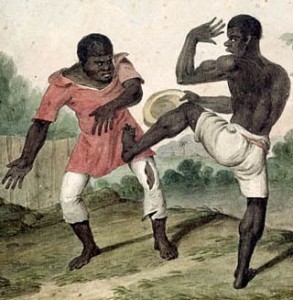 Anyhow, nothing allows us presently to make definitive statements on the music and its performance style before the Civil War, all the more because slave narratives have made it clear that not all music performed was meant to be heard by white ears. It is safe to suppose that music served as an outlet by which the slaves could channel their frustration and anger towards the white oppressor and that the lyrics were a secret communication channel to convey messages. Given the fear factor, it is not astonishing that some music which the slaves considered as potentially ‘disturbing’ for the planter was performed ‘underground’. Their ingenuity was impressive when it came to hide or to damp the sounds. Slave narratives report for instance on the use of buckets turned upside down to catch the sounds produced.
Anyhow, nothing allows us presently to make definitive statements on the music and its performance style before the Civil War, all the more because slave narratives have made it clear that not all music performed was meant to be heard by white ears. It is safe to suppose that music served as an outlet by which the slaves could channel their frustration and anger towards the white oppressor and that the lyrics were a secret communication channel to convey messages. Given the fear factor, it is not astonishing that some music which the slaves considered as potentially ‘disturbing’ for the planter was performed ‘underground’. Their ingenuity was impressive when it came to hide or to damp the sounds. Slave narratives report for instance on the use of buckets turned upside down to catch the sounds produced.
I quote, by way of illustration, one example of such an ante-bellum report based on observations in South Carolina, 1805, written down by a young tutor arriving on a plantation:
“() On my first waking, the sound of serenading violins & drums saluted my ears, and for some time continued. During almost the whole of the second and 3d afternoon, the portico was crowded with these dancers…fiddlers & drumming…Some of them who were native Africans did not join the dance with the others, but, by themselves gave us a specimen of the sports & amusement with which the benighted & uncivilized children of nature divert themselves…Clapping their hands was their music and distorting their frames into the most unnatural figures and emitting the most hideous noises in their dances…()” (Epstein, 2003:84).
It was no coincidence that the one who translated his amazement about the music he heard was the newly arrived young tutor and not the planter himself. There was little motive for the white residents to deposit to paper their opinions and thoughts on the sounds produced by the slaves. After all, why should they? In the first two centuries after the arrival of the first slaves in Virginia, the planters in the British colonies showed little or no interest at all in the cultural background of their working force. Not that the planters disliked music: it has been documented that slaves were hired to play for white parties and were also encouraged to play for their fellow slaves. Their interest in their musical performance was however of a pure instrumental nature: for the planter, the music performance was regarded as any other job the slave needed to execute. As for the music that slaves performed outside this context, it was quite exclusively seen by the planter in the perspective of its contribution to the continuation and productivity of the labour system. In other words, the white population defined to a very large extent the contours within which the Africans could experience their cultural life in general and their musical expression in particular. In this context, we tend to think immediately about the restrictions that were imposed on what, when and where slaves could play their music. From the quotation below from a contemporary observer we can however deduct that under certain circumstances, the ‘music’ making was more an obligation than a right:
“Slaves are generally expected to sing as well as to work. A silent slave is not liked by masters or overseers. “Make a noise”, “make a noise” and “bear a hand”, are the words usually addressed to the slaves when there is silence amongst them. This may account for the almost constant singing heard in the southern states. There was, generally, more or less singing among the teamsters, as it was one means of letting the overseer know where they were, and that they were moving on with their work” (Epstein, 2003:162).
The indifference on the part of the white population for the nature of the slaves’ dancing and their music gradually changed along with the increasing efforts from the Anglican Church and its dissident sects to spread religion among the slaves. The missionaries and their hierarchy justly observed that music was a central aspect to the African life, that it was embedded into their daily activities, that it was an integral part of everything they did. Music and dance were a means of communication and speech. They were not seen as an ‘art’ as we in our Western culture define it. In African culture, ‘art’ is functional, hence its central role. Music is one of the key elements of the texture of their social structure, and thus proofed to be the ideal channel through which the word of God could be spread. The natural musical inclination of the Africans was used as the hall stand on which the British hymns could be hung, all the more because there was a compatibility between the technique of call-and-response in the African culture and the lining-out style of hymn singing as it was applied across the Atlantic. Through the modelling of the musical life of the slaves, the missionaries discovered an effective way to spread the religious values. A bishop in London phrased it as follows:
“Many of the Negroes have a natural turn for music, and are frequently heard to sing in their rude and artless way at their work. This propensity might be improved to the purposes of devotion…by composing short hymns…set to plain, easy, solemn psalm tunes, as nearly resembling their own simple melody as possible. This might be used not only in church, but when their task was finished in the field, and on other joyous occasions. This would make them see Christianity in a much more pleasing light than they generally do…and would be found probably a much more effectual way of fixing their attention than any other that can be devised.” (Epstein, 2003: 108).
Most striking is the observation that the hymns “might be used not only in church, but (also) on other joyous occasions”. The aim was obvious: the ‘heathenish’ feasts and frolicking should be substituted by more pious ways of expressing their feelings not only in a religious setting but on any occasion, respecting at any time the devout Christian values.
In this context, it is comprehensible that there was an increased attention not only from outsiders, but also from locals for the musical expressions by the slaves. The more the Christianisation efforts were strengthened, the more attention was paid to what and how the slaves sung because the latter was conceived as a key instrument to the success of the conversion process. Pushed to its extreme, all dancing, be it African or European was equated with idleness, extravagance and sin, incompatible with the true religion.
The increased documentation of what in European terminology was labelled as ‘religious’ singing can thus be explained from the perspective of the conversion process. Together with language, the Christianisation was a major highway through which European values were transported in the African culture. Both were unifying forces that offered an answer for linking the different cultural backgrounds of the slaves when they arrived on American soil, forces which helped to shape the American culture.
It is thus no surprise that much less documentation exists with regard to the songs and dances performed at other than religious occasions. The available material points however to the probability that with a spread of the religious singing, ‘sacred’ components also entered the songs heard at those other occasions. Sacred texts gradually made their way for instance into the boat songs. “By the time the Northerners arrived in the Sea Islands in 1862, most of the songs were sacred. Many of the Northerners were unaware of a tradition of secular music among the blacks and sincerely believed that they sang only hymns ()” (Epstein, 2003: 171).
Hymns have been reported to be sung also in tobacco factories, and one document refers also to sacred text part in corn songs.
It was however in the first place the persistence of obvious African characteristics in the religious setting which drew the attention of the white part of the population. Loud singing, moaning and crying could not be reconciled with a public worship that needed to be conducted with reverence and stillness. It was expected that during congregational and camp meetings the African Americans sung ‘good psalms and hymns’ instead of “extravagant and nonsensical chants”.
By the way, the importance that the white church and the political system attached to the religious gathering of slaves was manifest in 1831 when in the aftermath of the Nat Turner slave rebellion Virginia passed new legislation not only making it unlawful to teach slaves, free blacks, or mulattoes to read or write, but also restricting all blacks from holding religious meetings without the presence of a licensed white minister. Other slave-holding states across the South introduced similar restrictions.
The disproportional attention for music performance in a religious context has thus lead to an imbalance of our knowledge on the songs performed during work, rowing, corn husking, cotton picking etc. This imbalance has long supported the wrong assumption that the slave singing dominantly consisted of a religious repertoire. It is rather ironic by the way that when this repertoire was still ‘unspoilt’ from religious influences there was little attention for it (for planters it was just an aspect of the slaves’ expression to be controlled, for the abolitionist music making was not compatible with his view of an oppressed slave), and that with the rising efforts at Christian conversion this aspect of the slaves singing was more and more attacked by almost the whole white religious community.
This is the context wherein Lucy McKim decided in 1862 to transcribe the lyrics that she heard in the most faithful way possible and to capture their rhythm and sense in the accompanying performance instructions. That was nothing less than revolutionary, never seen before and totally unlike the then dominant approach. Note that the American Folklore Society was founded only two decades later.
But as stated already above, time was not ready yet for the work of Lucy McKim since the publication of the two songs she sent to the Journal of Music met with little response from the public. Yet its importance cannot be underestimated as a first step had been set to spread the sounds of the African population as they truly echoed over the South, and not in the usual disfigured way with nothing else in mind than to make them acceptable for the audience. One can wonder whether this effort has been sufficient to turn the tide, i.e. to counteract the impact of the racist archetypes that were already being shaped by the ever popular black face minstrelsy.
The folkloric efforts of Lucy McKim and later by William Francis Allen and Charles Pickard Ware came indeed late knowing that Thomas Rice already scored stardom in 1832 with the song “Jump Jim Crow” and that by 1848, blackface minstrel shows were already the national art of the time. What is more, in the 1860’s all-black minstrel shows began to proliferate. They were often billed as “authentic” and “the real thing”, but in fact only put forth the image of the slaves as racially conceived by the white population.
The minstrelsy on the one hand and the folkloric efforts by Allen, Ware and McKim to reproduce the ‘true’ sound of the African on the other hand were symptomatic of a society which was deeply divided over the way to organise the relation between the white and black part of the population. Whilst one side applauded the minstrelsy that heralded nostalgia to the good old life on the plantation representing the African American as a lazy, simple-minded darky, the other side showed its deep appreciation for the unique contribution the Africans made to the American culture.
It is however most telling that even the publication of the ‘Slave Songs of the United States’ was far from a success, on the contrary. The public reaction was at the least ambiguous, going from defining it as ‘curious’ music to completely ‘worthless’ music. Most music journals even ignored it. One magazine left nothing to the imagination as to its opinion on it: “(Slave Songs of the United States is) hardly worthwhile to try to perpetuate this trash, vulgarity and profanity by putting it in print” (Epstein, 2003: 339). It would last until the end of the 1920’s before the collection was considered as a milestone in American folk study.
With this in mind the historical importance of the publication in 1862 of “Poor Rosy, Poor Gal” & “Roll, Jordan Roll” can only gain in significance. We fully corroborate Epstein (288) when she says that Lucy McKim accompanying her father to Port Royal is one of the most fortunate circumstances that could be imagined for American folk music.
_____________________________________
SOURCES
_____________________________________
The title of this inspired by the book : Roll, Jordan, Roll: The World the Slaves Made (1974), Eugene Genovese
– D. J. Epstein (2003) Sinful Tunes and Spirituals: Black Folk Music to the Civil War
– http://civilwargazette.wordpress.com/2007/11/01/the-capture-of-port-royal-november-1861-2/
– http://sciway3.net/clark/civilwar/coast.html
– http://www.blackpast.org/?q=aah/port-royal-experiment-1862-1865
– Akiko Ochiai, “The Port Royal Experiment Revisited: Northern Visions of Reconstruction and the Land Question,” The New England Quarterly 74.1 (2001): 94-117; Willie Lee Rose, Rehearsal for Reconstruction: The Port Royal Experiment (Indianapolis: Bobbs-Merrill, 1964).
– http://vfte.org/images/Port_Royal_Experiment.pdf
– http://www.on.literacy.ca/hist_lit/lcp/2
– http://www.nndb.com/people/643/000203034/
___________________________________________________
FOOTNOTES
___________________________________________________
(1) Epstein, Dena J. Sinful Tunes and Spirituals: Black Folk Music to the Civil War. Chicago: University of Illinois Press, 1977/2003.
“It’s seldom that you can say of a book that it is a definitive study, but it is difficult to think of anything that could be usefully added to Epstein’s landmark study. She was not a musicologist and she did no work in the field as a collector of music or folk-tales. She was, however, a librarian with a passion for research and she devoted nearly twenty years of exhaustive research to locate and document every reference to slave music from the earliest known references in the American colonies and the Caribbean to the historic first collection of slave songs begun during the Civil War. She has examined travel literature, government reports, memoirs, letters, newspaper writing, articles in journals, and she also turned to archives of unpublished papers of anyone who might have some description of music they’d heard. The writing is clear and concise, and manages to capture the sense of her own excitement at the material she was finding. The book can be sampled at random, since there is something of importance on virtually every page, but for any reader who reads it through they will be rewarded with the final chapters which tell the engrossing story of the compilation of the first collection of slave music, Slave Songs in the United States (present in the Archive) in 1867. She describes the backgrounds of the research, she documents the books inception and publication, and she presents biographical portraits of the book’s three young editors, Lucy McKim Garrison, Willam Allen, and Charles Ware.
Throughout the book Epstein quotes liberally from the descriptions of music and performance she has found and her documentation is impeccable. She also was tireless in her efforts to locate rare associated materials, and among the most illuminating of her discoveries are the two examples of slave songs which were published under her maiden name by Lucy McKim Garrison in 1862. These were the first serious attempts to preserve slave’s musical expression, and her sensitive settings have not lost the distinctive qualities of the singing. The two publications are reproduced in the text.”
(quotation Charters Archive, http://doddcenter.uconn.edu/findaids/charters/MSS20000105.html)

